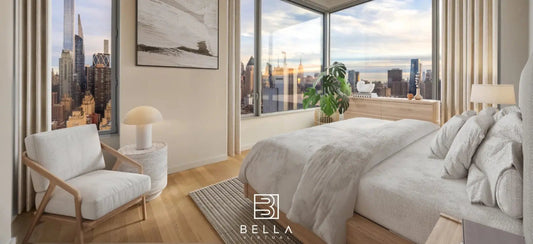If you are preparing to list, you might ask, is home staging worth it. This article explains how smart presentation boosts perceived value, speeds offers, and protects pricing power. We outline practical steps, show where returns come from, and share when virtual options outperform full installs. With clear examples and a decision framework, Bella Staging helps you move from photos to offers with confidence.
Highlights
- Stronger online impact: Staged thumbnails lift clicks, proving is home staging worth it.
- Price uplift potential: Neutral styling increases offers.
- Speed to contract: Virtual staging accelerates listings, confirming is home staging worth it.
What Home Staging is?
Staging prepares a property to communicate scale, light, and function in photos and tours. It differs from decorating, which personalizes a home for the owner. Staging de-personalizes so more buyers visualize living there and quickly judge fit.


Effective staging starts with buyer-profile alignment, then sets traffic flow and sightlines. It can be achieved with targeted vignettes, full installs, or digital alternatives that keep budgets tight and timelines short. For sellers wondering is home staging worth it, these strategies often prove that even modest investments can significantly enhance buyer perception and selling speed.
- Clear purpose: Present rooms for scale, light, and daily use.
- Buyer focus: Align style choices with local comps and audience.
- Flexible methods: Mix physical edits with virtual assets as needed.
See more: Top 10 Staging Home Services Every Realtor Recommends
10 Reasons Sellers Say Yes to Home Staging
1. Stronger Online First Impressions
Most buyers meet your home as a small thumbnail and a short caption. Clear, home staging images create visual hierarchy, so the eye reads proportion, natural light, and primary features instantly.
Good galleries begin with wide, well-lit anchors that communicate layout. Sequenced photos then reinforce scale and function. This flow increases clicks and saves, which drives showings and momentum during the first weekend.
- Lead with scale: Show full room width and circulation.
- Sequence logically: Anchor shots first, details later.
- Control clutter: Every edge, surface, and line matters.
2. Higher Perceived Value At Showings
In person, balanced furniture placement and tidy sightlines make rooms feel larger and better maintained. When visual noise drops, buyers focus on strengths and agree more readily with price.
This effect compounds if online expectations match the tour. Staging that mirrors the gallery builds trust, which lowers negotiation friction and keeps repair requests proportionate to real issues rather than first-impression doubts.
- Consistent story: Gallery and tour should feel aligned.
- Sightline management: Keep long views open and clean.
- Neutral base: Let light and space carry the value.
3. Best Rooms Drive Disproportionate ROI
The living room, kitchen, and primary bedroom anchor emotion and pricing logic. Investments here lift overall perception, even when the rest of the home is treated lightly.
Focus each space on how buyers live day to day. Clarify conversation areas, dining flow, and storage cues. In kitchens, crisp counters and a single cohesive accent read as clean and upgrade-ready without costly overhaul. For those asking is home staging worth it, these subtle refinements often deliver strong visual impact and faster buyer engagement at minimal cost.
- Living room scale: Right-size seating to the volume.
- Kitchen clarity: Clear counters, add one unifying accent.
- Primary calm: Hotel-clean bedding and balanced lighting.
4. Reduces Buyer Objections and Repair Focus
Neutral palettes and simplified surfaces redirect attention away from small imperfections that often fuel discount requests. When rooms feel purposeful and calm, buyers perceive care and quality.


This does not hide problems, it gives accurate context. With fewer distractions, inspection conversations stay balanced and centered on material issues. Sellers maintain asking power because first impressions set a confident tone.
- Visual calm: Lower noise to raise trust.
- Context first: Frame minor flaws against clear benefits.
- Fewer concessions: Preserve price with better perception.
5. Shorter Days on Market Across Price Bands
When images set accurate expectations, qualified buyers act faster. That reduces idle days that can invite price cuts, and it preserves negotiating power throughout the process.
A clear gallery also helps agents guide serious prospects to the property first. This prioritization increases tour density in week one, which often brings stronger initial offers that you can compare with less time pressure.
- Qualified traffic: Photos pre-qualify interest early.
- First-week focus: Concentrate showings when urgency peaks.
- Price integrity: Fewer cuts, cleaner contracts.
6. Stronger Lead Quality From Better Photos
Staged photos answer scale and layout questions that typically cause hesitation. The inquiries you receive are more intentional, which boosts tour-to-offer conversion and keeps negotiations constructive.
This step also improves how the listing performs in portal algorithms. Higher click-through and save rates signal relevance, which surfaces your home to more similar buyers with less paid promotion.
- Answer questions: Show scale, flow, and storage.
- Boost conversion: More intent, fewer tire-kickers.
- Algorithm lift: Engagement surfaces the listing further.
7. Virtual Staging Delivers Speed and Budget Control
Virtual assets give Vacant rooms purpose and proportion while limiting carry costs. You still perform basic cleaning and lighting adjustments, but the online gallery does most of the selling work.


This hybrid approach is efficient in shifting markets. You keep spending focused on visible results while maintaining flexibility if the listing strategy evolves during the campaign.
- Vacant clarity: Show function without full installs.
- Cost focus: Pay for impact, not logistics.
- Adaptable plan: Adjust quickly as feedback arrives.
8. Appraisal Readiness and Listing Confidence
Orderly, well-presented spaces help appraisers and buyers read condition accurately. Clear photos and tidy tours reduce ambiguity, so value discussions start closer to your target.
When presentation aligns with comps, support materials, and disclosures, stakeholders move decisively. The process feels professional and predictable, which keeps momentum through underwriting and closing.
- Clarity helps: Clean lines communicate care and condition.
- Comp alignment: Match presentation to neighborhood norms.
- Paper trail: Prep documents to reinforce perceived value.
9. Negotiation Leverage Through Increased Interest
More qualified attention creates optionality. Multiple interested parties compress timelines and strengthen your position on price and terms. When sellers weigh is home staging worth it, results like increased competition and stronger offers often make the investment self-evident.
Staging creates that momentum by telling a coherent story from thumbnail to tour. With better first impressions, you field earlier, firmer offers and negotiate from strength rather than urgency.
- Early momentum: Interest clusters in the first weekend.
- Stronger offers: Confidence reduces discount hunting.
- Better terms: Leverage improves timelines and contingencies.
10. Vacant Property Strategy Maximizes ROI
Empty rooms often read smaller and colder in photos according to the Bella Staging experiance. Purposeful virtual vignettes add scale cues, visual warmth, and a cohesive style that translates from pixels to walkthroughs.
This method turns a potential weakness into a selling point. The gallery sets expectations, tours feel aligned, and buyers leave with a memory anchored to livable scenes, improving offer quality without heavy upfront expense.
- Scale cues: Furniture choices communicate volume.
- Cohesive story: Consistent style across the gallery.
- Lower carry: Reduce time-based holding costs.
Is Home Staging Worth It for Price Uplift and ROI
Staging works by reducing friction that erodes perceived value. Clean lines, balanced color, and purposeful layouts shift attention from small flaws to livability—often translating into stronger list-to-sale ratios and fewer concessions.
According to recent national data, nearly three in ten agents said staging led to offers 1%–10% higher and about half (49%) observed shorter time on market; most buyers’ agents also report staging helps buyers picture themselves in the home.
- Targeted spend: Put budget into rooms that sell the home.
- Visible gains: Improve list-to-sale ratio and reduce discounts.
- Negotiation strength: Fewer objections, cleaner offers, faster close.
Is Home Staging Worth It for Faster Sales
Speed is leverage. When serious buyers self-select early, you carry fewer days on market and feel less pressure to cut price. Staging reduces uncertainty, so the path from listing to offer shortens.
Digital workflows accelerate that momentum. By publishing photorealistic visuals through 3D rendering services, you can launch compelling images fast while you finish light in-person prep. And because Bella offers both branded and unbranded catalogs, you can align visuals with either shoppable, name-brand pieces or clean, neutral sets that fit your marketing strategy.
- Momentum effect: Early interest raises perceived value.
- Clarity sells: Fewer questions, faster decisions, better offers.
- Lean timeline: Publish quickly, then refine in person.
Why Bella Staging Delivers More Value
A style brief defines the target buyer and the look of comparable listings. Colors are calibrated so images stay accurate on MLS and portals. Crops are optimized for thumbnail clarity, which lifts click-through and showing requests.
For time-sensitive sellers, virtual options like virtual staging create high-impact galleries without furniture logistics, helping you launch quickly while keeping the visuals consistent and market-aligned.
- Buyer-first brief: Align aesthetics to real demand.
- Color accuracy: Reliable tones across devices and MLS.
- Thumbnail logic: Crops that win attention quickly.
Why Bella Staging Accelerates Offers
You provide photos and a short brief. Within roughly one day, you receive styled images aligned to comps and buyer profile. You request refinements, then publish a gallery that reads cleanly at thumbnail size and full screen.
That speed builds momentum between photo day and the first weekend. Serious buyers act sooner when the story is coherent online and in person.
- Fast cycle: Turn images quickly for launch.
- Refinement loop: Tight feedback keeps quality high.
- Launch ready: MLS-friendly crops and sequencing.
Watch more: 10 Best Home Staging Companies for Small Homes and Condos
FAQs: Is Home Staging Worth It?
1. Is home staging worth it in a seller’s market?
Yes. Even with limited inventory, staging sharpens first impressions and protects pricing power by signaling care and move-in readiness. Buyers feel more confident, which reduces renegotiations and keeps attention on layout and light rather than on small flaws.
Aim for neutral color, clean sightlines, and clear room purpose. Sequence wide anchor photos first, then detail shots. If time is tight, publish a virtual gallery while completing basic in-person prep so tours match the online story.
2. Which rooms should I prioritize to make staging worth it?
Focus on the living room, kitchen, and primary bedroom. These spaces drive most of the emotional decision and photo performance. If the budget is limited, direct resources here first to influence perceived value and tour conversion.
Round out the plan with a tidy entry and refreshed baths for continuity. Ask your agent which angles perform best in your MLS so the first three images carry scale, light, and a strong focal point.
3. How much does staging cost and what ROI is realistic?
Budgets vary by market and scope, but targeted staging usually pays through stronger offers and fewer concessions. National reports document price and time benefits, which supports a practical yes to is home staging worth it for many listings.
To estimate ROI, compare your gallery against recent sold comps. If yours looks underdressed, you are likely leaving money on the table. Spend where photos persuade, then keep showings aligned with the images buyers loved.
4. Is virtual home staging worth it compared to physical staging?
For Vacant or time-sensitive listings, virtual staging creates compelling photos at lower cost and on a faster timeline. It is especially effective for online discovery, where thumbnails drive traffic and showing requests.
Pair virtual images with basic in-person prep. Keep floors spotless, lighting consistent, and rooms clearly labeled for function. This hybrid keeps costs predictable while making the home easy to visualize.
5. Do I need to stage a Vacant property differently?
Yes. Vacant rooms need scale cues, warm color, and a clear function to avoid feeling small and echoey. Virtual or targeted vignettes supply those cues without the cost of full installs.
For photos, prioritize wide angles that communicate flow and storage. For tours, maintain pristine surfaces and open circulation paths. The goal is to help buyers imagine daily life with minimal friction.
Conclusion
The evidence and buyer behavior say is home staging worth it. Staged listings present clearer value, move faster, and negotiate from strength. If you want a right-sized plan that fits your price point and timeline, Bella Staging can help with fast, consistent visuals and clear guidance. To start a tailored plan or request proposals, contact us now.














